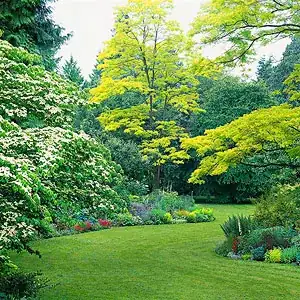
Please send a few pictures. Now is the time to make plant beds, edges to your lawn. Tulips need to be dug up, beds double dug, put bulbs on sheets of newspaper and then replant by making a mass planting. Don't plant any straight lines. If you need more bulbs that can be done later. There are far better 'color spot' plants than tulips. To include lovely tidy flowering shrubs. As you dig, clean out grasses and weeds and ignore any rocks smaller than your fist.
Your plant beds that you design, need to be raised above the level of grass of your lawn (by double digging ONE time a good foot deep, raking, firming, then mulch will give you a foot high bed...it will be higher at first but will soon be planted, settled) a little trench between grass and plant beds. This makes the best edge to your lawn and helps with keeping grass in the lawn not the beds. Pretty, simple, clean lines. Also helps with drainage.
Make radius of curves to your lawn consistent; change the radius for the next curve only when you change the radius point. No compound curves in other words? Radius measurements can change of course but once you start a curve stay with that measurement until reversing the curve and moving the point of the radius to the outside of the lawn and vice versa.
Draw on paper to scale. Look in your mortgage papers for an AS-BUILT. Should show property lines, N/S, the footprint of your home, sheds, hard surfaces, underground utilities, septic tank if you have one. Get that done and I'll walk you through a simple master plan for your yard. Don't just start with the tulip bed. You need to see a bigger picture so you don't do things twice. The plan of your yard will always be changing but you want a foundation planting and have your yard elements relating with one another.
How much do you know about lawns? Do you have all the proper tools? I am asking because a lawn is a lot of work and there are other alternatives to lawns. A small judiciously placed lawn with beautiful curves is better than a blanket of acres of lawn.
As you draw your BASE PLAN, one of the rules in Landscape designing is to not be able to see your entire landscape from the doors and windows of your home. In the picture below, there is a 'peninsula' of plant bed blocking the view beyond. Little peekaboos and the sweep of lawn clearly show there is more to the picture and causes humans to want to walk out there and look around the corner.
This is the beginning of 'outdoor rooms'. Outdoor rooms linked together. Rooms that are defined by edges, the trunks of trees, architectural elements such as screen panels and pergolas and arbors are great in helping to make these rooms some with privacy, as well as tying the home architecture into the landscape.
Do you have irrigation? Where are your hose bibs? Do you want a patio, hot tub, fire pit? Do you have a deck? This is truly so much fun to put pencil to graph paper and imagine. Start taking pictures of stuff you like as you drive through the neighborhood. Are you in a housing development with rules and codes and as someone recently called them; the Nazi Housing Association?
You have to know what those rules are. Tell us more about your property; such as where on this planet you live?
Rewrite your question to simply ask how to get started designing your blank slate!
